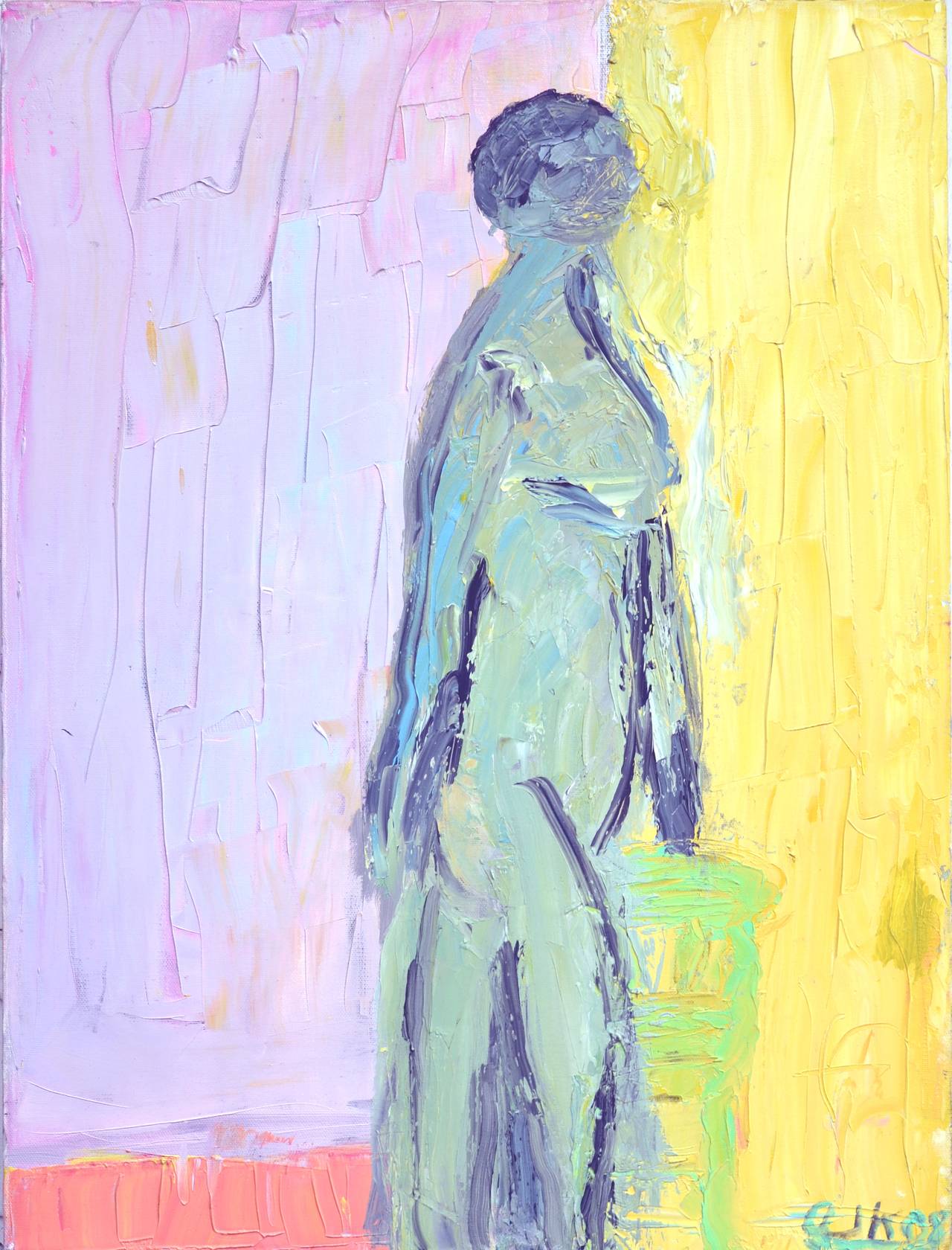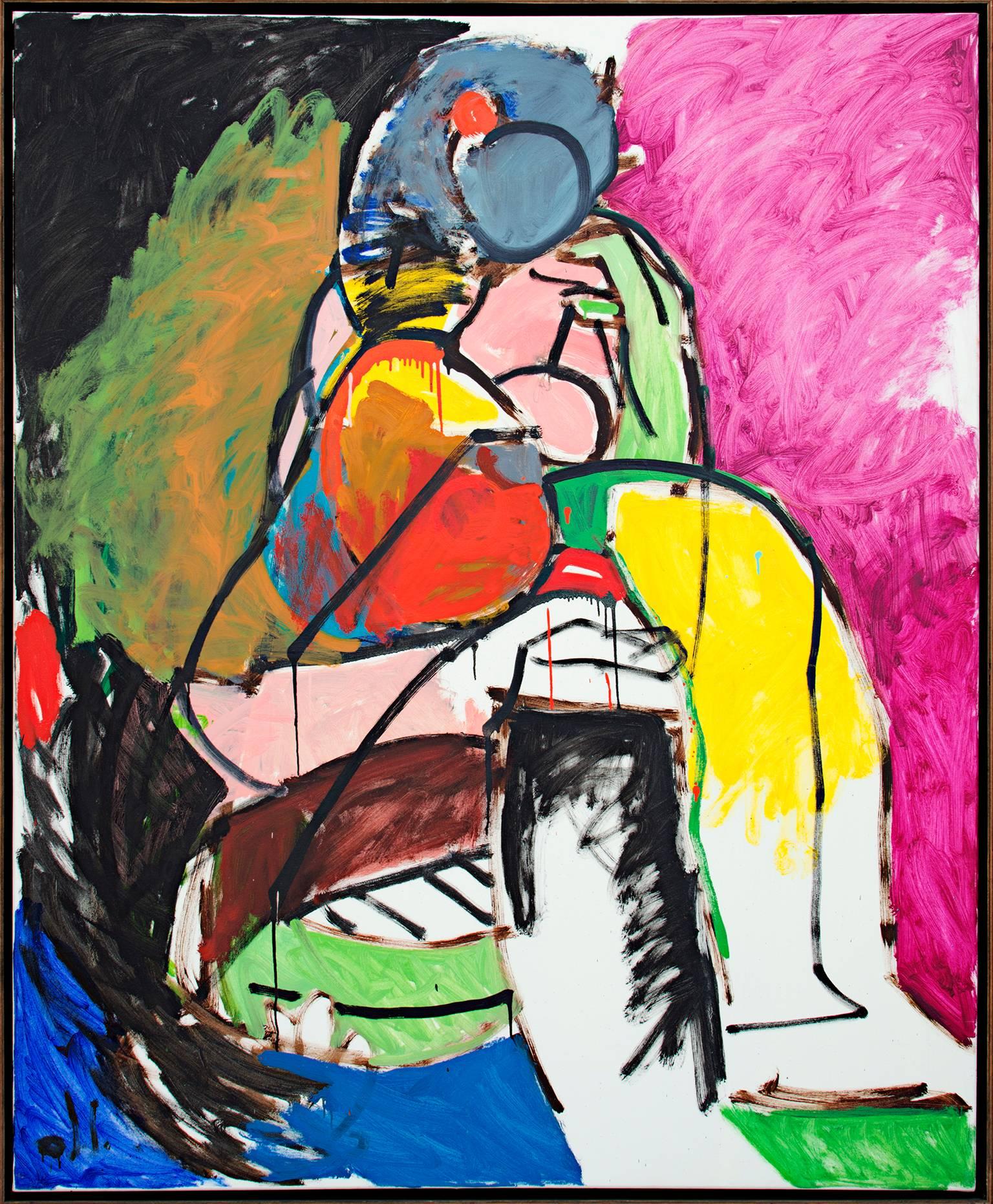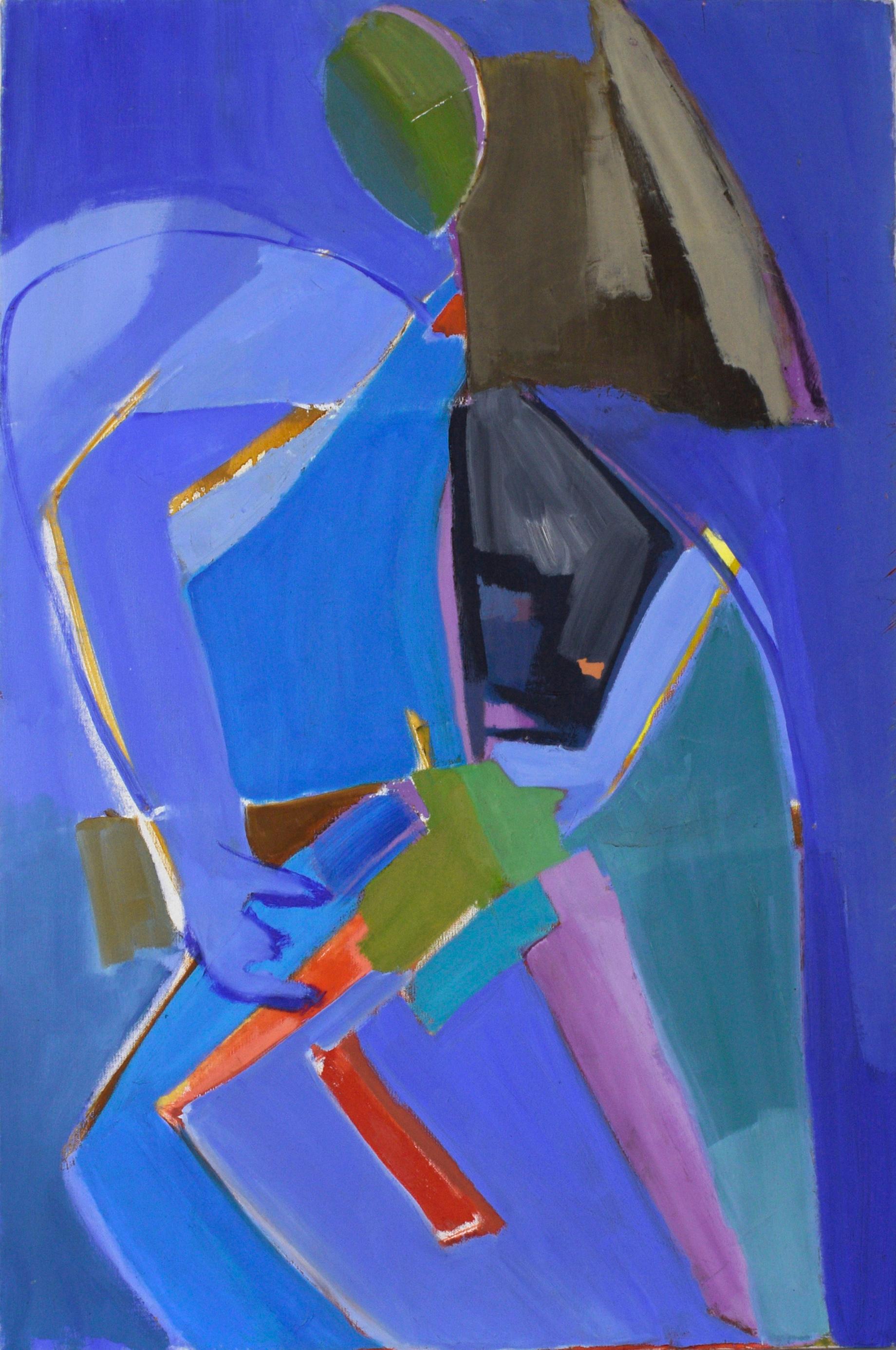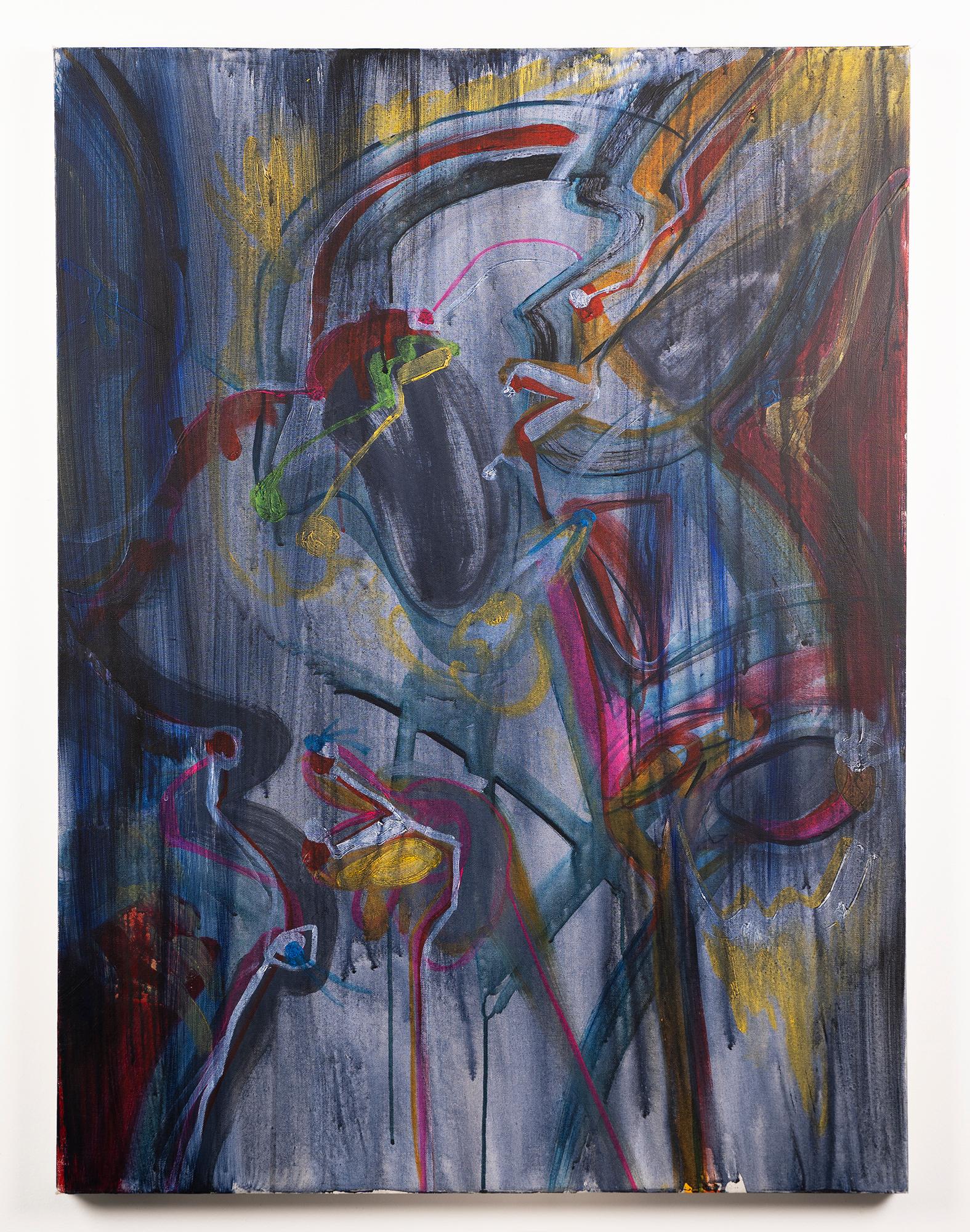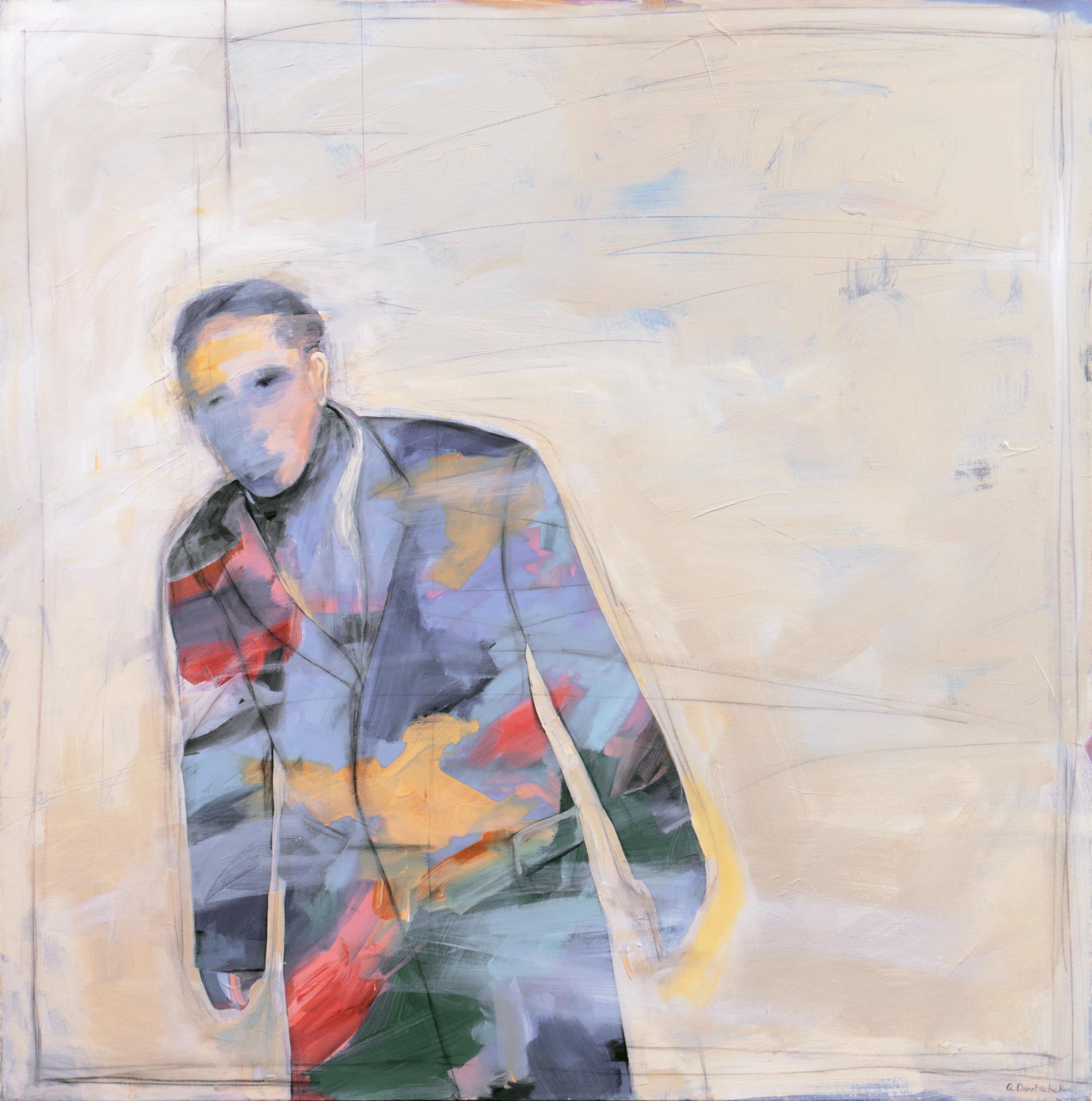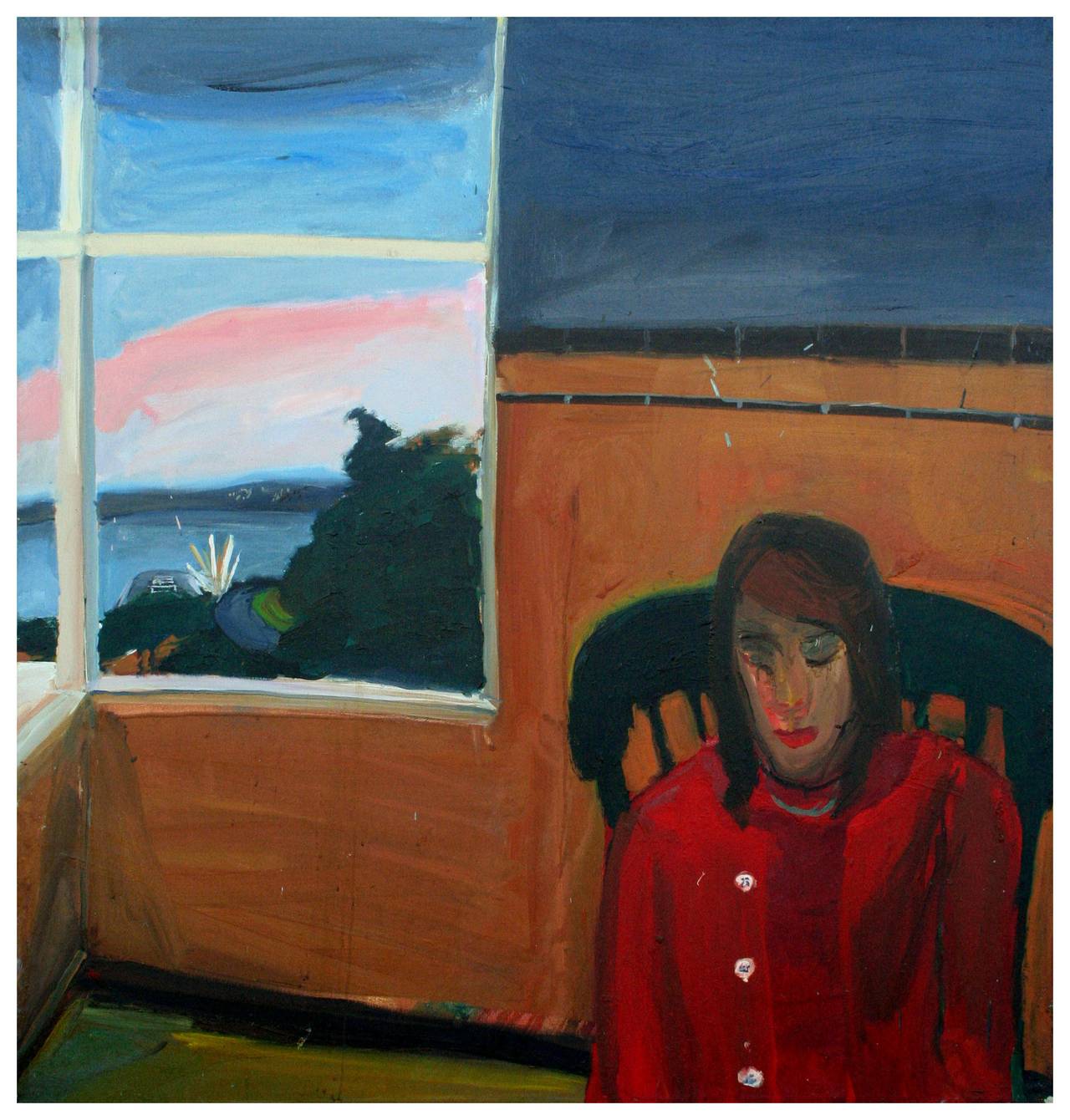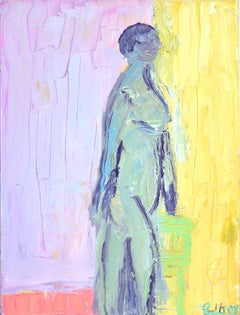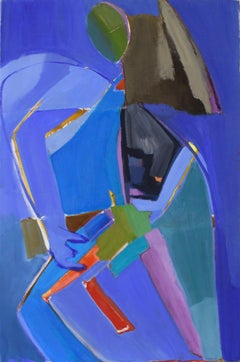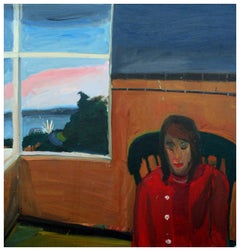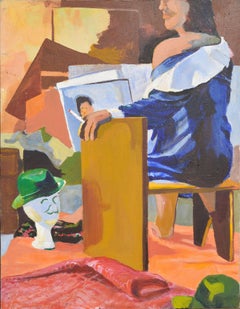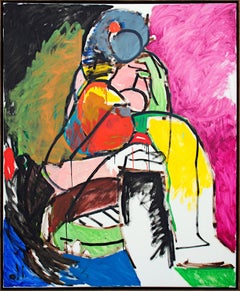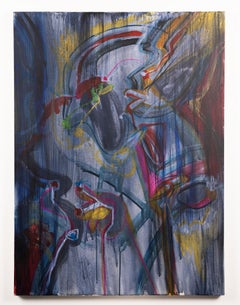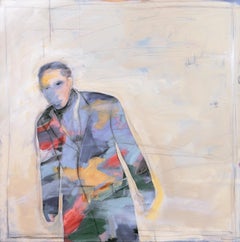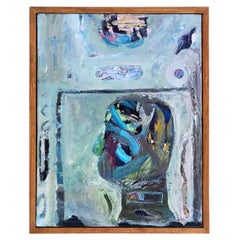Items Similar to "The Gate Keeper", Bay Area Figurative Abstract
Want more images or videos?
Request additional images or videos from the seller
1 of 15
John Hoft"The Gate Keeper", Bay Area Figurative Abstract1988
1988
$3,250
£2,481.64
€2,825.43
CA$4,563.51
A$4,988.81
CHF 2,639.31
MX$59,699.17
NOK 33,581.39
SEK 30,740.36
DKK 21,104.24
About the Item
A highly abstracted figure emerges in fluid, elegant brush strokes, reminiscent of the works of Francis Bacon, in this striking abstract painting by Bay Area Figurative artist John Hoft (American, 20th century). The figure's face, like Bacon's, is a smear of colors in motion, which contrasts with the sharply rendered black form of the torso.
Signed and dated "J. Hoft 88" lower right.
Titled "The Gatekeeper" on verso.
Presented in a custom wood window box frame, painted black with navy blue recessed border.
Image size: 35"H x 23"W.
A Bay Area Figurative artist known for abstract figural works, John Hoft exhibited widely in the San Francisco Bay Area in the late 1980’s and early 1990’s. Several of his works were included in the collection of the George Krevsky Fine Art Gallery in San Francisco. Hoft, born in 1947 in Milwaukee, now lives near San Francisco in Albany, California, where he works at various construction-related jobs. He recalls the 50s as a period of conformity that “pushed people into doing things they didn’t have the means for”–like his father, a “jack-of-all-trades type” who “suffered greatly” from the pressures to conform. Hoft’s experience with building materials seems to inform the present work; he produced the colored plaster surfaces using a process of his own invention that he won’t divulge.
It doesn’t matter: the effects are what riveted me. Ethos looks almost random at first–it’s as if Hoft were avoiding any one system of mark making. A piece of twisted sheet metal sits in front of pale brown-and-green plaster whose design breaks down into three distinctly different sections–in one, brown lines appear to be incised in the plaster, while another includes raised brown areas. Hoft makes the viewer vacillate between recognition of the solidity of things–the metal plate–and meditation on ethereal patterns whose origins are a mystery.
Other exhibitions include:
The Weir Gallery, Oakland, 1987
Vision Gallery, San Francisco, 1988
Hoffman Gallery, Emeryville, 1989
Griffith Gallery, San Francisco
Perimeter Gallery, Chicago 1991
- Creator:John Hoft (American)
- Creation Year:1988
- Dimensions:Height: 37 in (93.98 cm)Width: 25 in (63.5 cm)Depth: 2.25 in (5.72 cm)
- Medium:
- Movement & Style:
- Period:
- Condition:Painting is permanently mounted onto custom window box frame.
- Gallery Location:Soquel, CA
- Reference Number:Seller: JT-7464*1stDibs: LU5429277352
About the Seller
5.0
Platinum Seller
Premium sellers with a 4.7+ rating and 24-hour response times
Established in 1986
1stDibs seller since 2014
3,057 sales on 1stDibs
Typical response time: <1 hour
- ShippingRetrieving quote...Shipping from: Soquel, CA
- Return Policy
More From This Seller
View AllBay Area Figurative Movement, "Waiting For Her Lover" Figurative Abstract
By Arthur Krakower
Located in Soquel, CA
Fantastic figurative abstract color field painting by Northern California artist Arthur Krakower (American 1921-2009). C. 2008. Monogram "AJK 08" lower right corner. Unframed.
Arth...
Category
21st Century and Contemporary Contemporary Figurative Paintings
Materials
Canvas, Oil
Bay Area Cubist Figure in Oil on Canvas
Located in Soquel, CA
Bay Area Cubist Figure in Oil on Canvas by Ellis Hopkins (American, b. 1952).
This vibrant cubist-inspired composition depicts a seated figure abstracted into interlocking planes o...
Category
Late 20th Century American Modern Abstract Paintings
Materials
Acrylic, Canvas, Stretcher Bars
$1,200 Sale Price
20% Off
Mid Century Bayside View, San Francisco
By Sally Kissinger Wilt
Located in Soquel, CA
Stunning large-scale, Bay Area Figurative School, painting of a woman sitting by a window overlooking a lakeside view, influenced by her teacher Richard Diebenkorn, by Sally Kissing...
Category
1960s Abstract Expressionist Figurative Paintings
Materials
Canvas, Oil
Bay Area Figurative Movement -- Cigarette Break
By Patricia Gren Hayes
Located in Soquel, CA
Wonderful figurative by Patricia Gren Hayes (American, 20th Century). Signed on verso. Unframed. Size: 30"H x 40"W.
Bay Area Figurative / Bay Area Feminist Art Movement artist, Patricia Gren-Hayes, studied at Winnipeg Public Art School in 1950. She received early recognition in Museum and Gallery competitions and exhibitions and was awarded a Special Education in Art recognition by the Winnipeg Museum of Fine Art, and was awarded a scholarship to the Banff College of Fine Art. Further studies were at The University of Manitoba.
She was a Member of Winnipeg Free Press Sketch Club and was a Cartoonist and paste-up for a French-English bi-weekly, in Eastern Canada;
She studied outdoor impressionism in New York in 1960; in 1962, attended The California College of Arts and Crafts, and in 1976 B.A., U.C. Berkeley where she studied under Elmer Bischoff, David Simpson, Joan Brown, Felix Ruvolo, Yolanda Lopez and Vincent Perez...
Category
1960s American Modern Figurative Paintings
Materials
Canvas, Oil
Bay Area Abstract Painting with Viridian Green Square
Located in Soquel, CA
Abstract Composition with Viridian Square by Ellis Hopkins (American, b. 1952).
This abstract composition features bold brushstrokes and highly contrasting colors. A large blue sha...
Category
Late 20th Century American Modern Abstract Paintings
Materials
Stretcher Bars, Linen, Acrylic
$2,920 Sale Price
20% Off
Bay Area Abstract Expressionist Standing Nude
By Honora Berg
Located in Soquel, CA
Bay Area Expressionist Standing Nude
Standing nude woman by Honora Berg (American, 1897-1985). Bold depiction of a nude woman with dark hair. The model is rendered in dark greys, w...
Category
1950s American Modern Nude Paintings
Materials
Oil, Paper
You May Also Like
Modern Abstract Female Figure Statement 1990s Portrait Painting Large Signed
By Matthew Schaefer
Located in Milwaukee, WI
"Abstract Woman" is an original oil painting by Matthew Schaefer. It depicts a woman in bright shapes and lines instead of solid form and naturalism. Matthew Schaefer's painterly sty...
Category
1990s Abstract Expressionist Figurative Paintings
Materials
Canvas, Oil
American Modernist Abstract Portrait Dancer Original Oil Painting
Located in Buffalo, NY
Vintage American modernist oil painting. Oil on canvas, circa 1970. Unsigned. Image size, 30L x 40H. Framing available.
Category
1970s Abstract Abstract Paintings
Materials
Canvas, Oil
$396 Sale Price
20% Off
'Coat of Many Colors', California Figurative Abstraction, Pacific Art League
By Amanda Danitschek
Located in Santa Cruz, CA
Signed lower right, 'A.Danitschek' for Amanda Danitschek (American, born 1956) and painted circa 2010. Additionally signed, verso, and titled, 'No One Said It Would Be Easy'.
A subs...
Category
2010s Modern Figurative Paintings
Materials
Canvas, Oil, Pencil
Vintage Warren Fischer Figurative Abstract Painting
By Warren Fischer
Located in Miami, FL
Vintage Warren Fischer figurative abstract painting.
Offered for sale is a figurative abstract painting on canvas by the American artist Warren Fischer (1943-2001). The painting is ...
Category
Late 20th Century American Modern Paintings
Materials
Canvas, Wood
5320 - Framed Original Abstract Figurative Artwork
Located in Los Angeles, CA
Blurring the distinction between figure and abstract settings, Swiss artist Edith Konrad’s spectral forms—human in shape—inhabit muted abstract environments punctuated by vivid burst...
Category
21st Century and Contemporary Contemporary Figurative Paintings
Materials
Canvas, Mixed Media, Oil, Board
$440 Sale Price
20% Off
Untitled, Figure Study
By Hans Burkhardt
Located in Palm Desert, CA
"Untitled, Figure Study" is an abstract figurative Post War pastel on paper paintings by Hans Burkhardt in 1967. The artwork is 21 1/4 x 16 1/4 inches and, with the frame, is 28 3/4...
Category
20th Century Post-War Abstract Paintings
Materials
Paper, Pastel
More Ways To Browse
Used Building Materials
Vintage Wood Gate
Francis Bacon Painting
Propaganda Art
Black White Photography Mick Jagger
Elephant Prints
Clark Antique
Exhibition Poster Black And White
French Paintings 1920
Tiger Print Art
Vintage Pop Art
Wanted Poster
La Scala
19th Century Gouache
Lithograph Horses
Antique Prison
Black Acrylic Sculpture
Brigitte Bardot Photographs
